There’s a lot of misunderstanding and myth circulating about how many ships the shipyards on the Clyde are expecting to build, but what’s the truth?
The chopping and changing when it comes to the requirements of the Royal Navy in terms of ship classes, numbers and even the building of those ships has caused a great deal of misunderstanding and confusion, not least when discussing Scottish politics.
Shipbuilding on the Clyde became controversial during the 2014 Scottish Independence Referendum, when the pro-union ‘Better Together’ campaign touted the planned Royal Navy order of 13 Type 26 Frigates to be built on the Clyde as a benefit of Scotland remaining in the United Kingdom.
Essentially, people believe that Scotland was promised 13 warships.
The issue? The future composition of the Royal Navy surface fleet was changed after a defence review in 2015 resulting in five of those frigates being cancelled and replaced with cheaper general purpose vessels, amid cries of ‘betrayal’ but why did this happen?
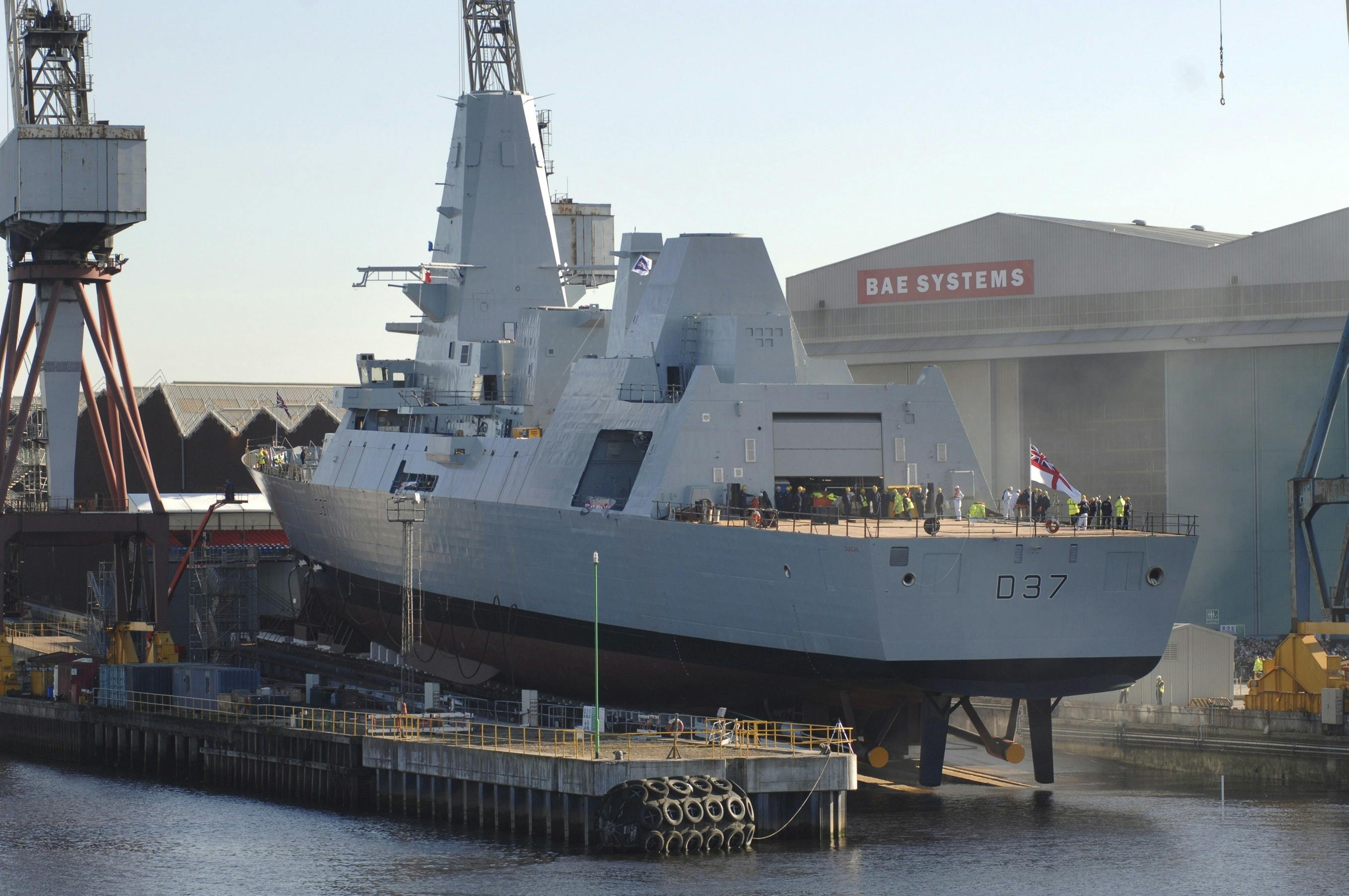
Why were Type 26 numbers reduced?
The initial Type 26 Frigate order had been cut back from 13 to 8 in order to fund more of the immediate spending outlined in the 2015 Strategic Defence and Security Review. As a result of Type 26 being reduced to 8 ships, it was announced that five cheaper general purpose frigates were to be designed and ordered.
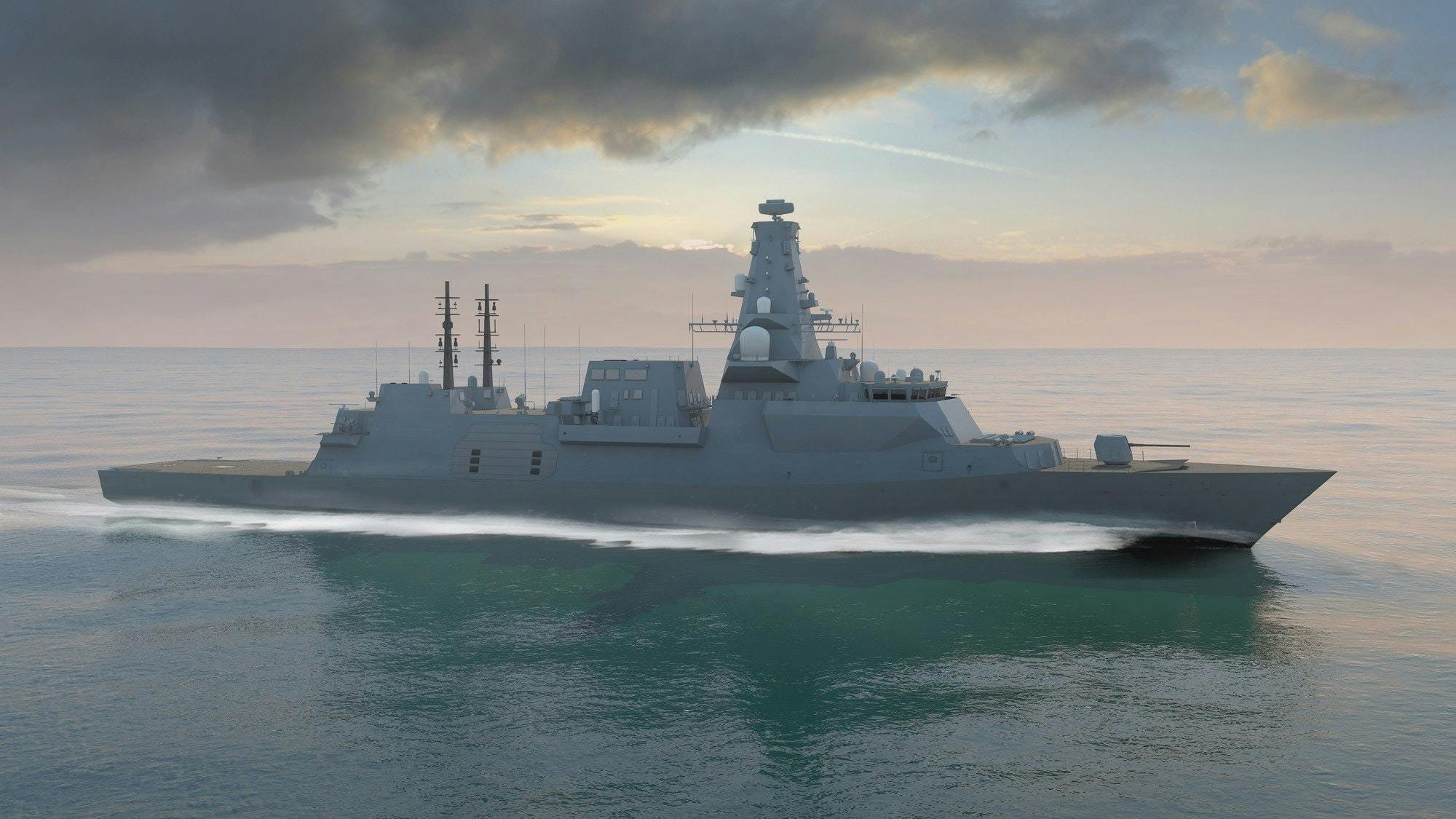
Part of the reason for this is that the MoD is hoping to reduce its reliance on BAE and cut the costs of procurement by spreading shipbuilding work across civil and naval yards around the UK. To this end, the UK Government say they are implementing the results of an independent report into the National Shipbuilding Strategy by Sir John Parker which recommended that the Type 31 Frigate build be spread across the UK, with blocks and components being constructed in yards in both Scotland and England.
The National Shipbuilding Strategy was intended to be a “radical, fundamental re-appraisal of how we undertake the shipbuilding enterprise in the UK, intending to place UK naval shipbuilding on a sustainable long term footing”.
The news that BAE decided not to bid to assemble the Type 31e Frigate on the Clyde due to an apparent lack of interest created a stir in Scotland after earlier expectations that the light frigates would be built there.
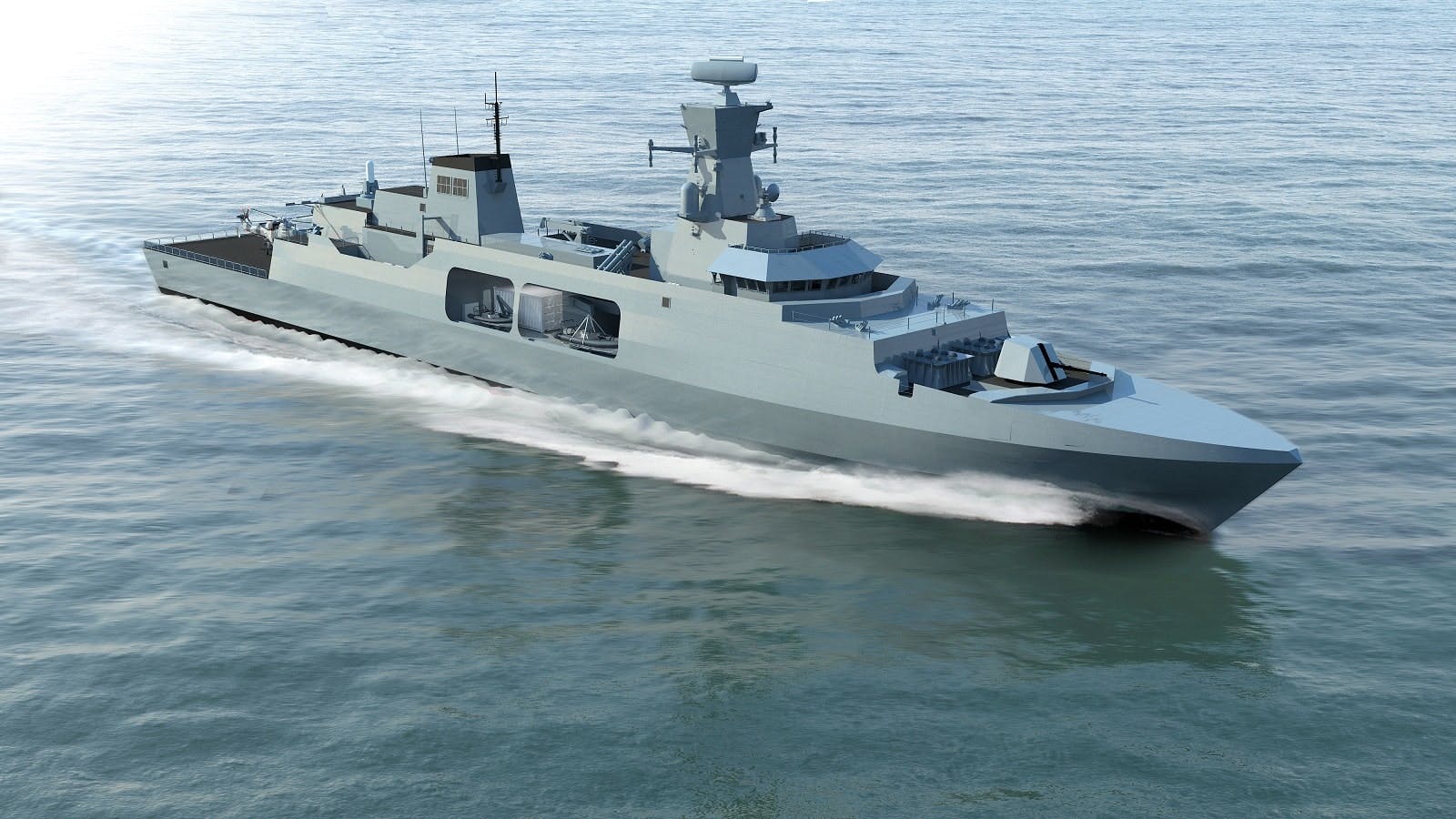
However, BAE themselves say that shipbuilding capacity on the Clyde will be maxed out until the mid 2030s while the Ministry of Defence want the first of the new Type 31 Frigates in service by 2023, one of the primary reasons they have decided not to bid as prime contractor for the project, there’s no space at the BAE yards on the Clyde to do so if they are to meet the deadline for the first Type 31e to hit the water.
BAE say the move will allow them to ‘appropriately support the National Shipbuilding Strategy’ whilst ensuring the delivery of the five Offshore Patrol Vessels and the City class Type 26 frigates currently on contract, ‘to time, budget and to the highest quality standards.’
In a press release BAE say:
“BAE Systems is focused on the manufacture and delivery of the two QE Class carriers, the five River Class Offshore Patrol Vessels (OPV) and the first three City class Type 26 warships, as well as continuing to develop and upgrade combat management systems on all Royal Navy ships. Taking account our current and future workload, including Type 26, our shipbuilding capacity on the Clyde will be full until the mid 2030s.”
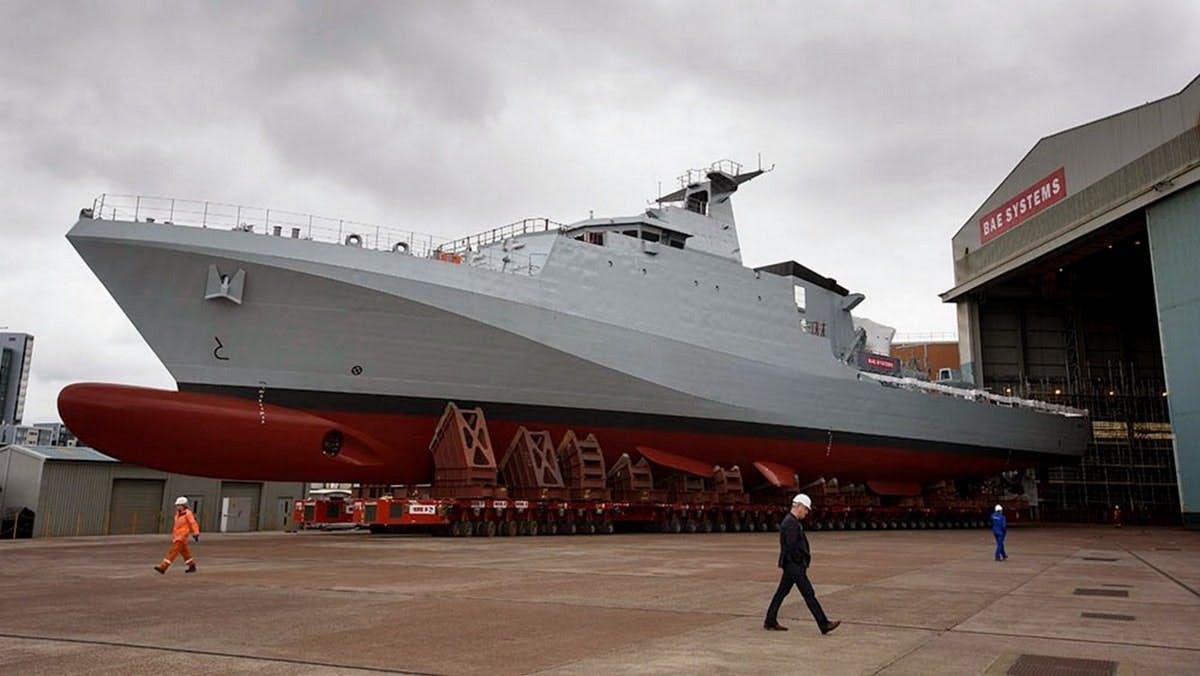
BAE also signalled their reluctance to bid for the Type 31 Frigate as prime contractor due to concerns of a “race to the bottom” on price. Speaking to The Herald here, BAE managing director Iain Stevenson signalled the defence firms lack of interest on building the vessel:
“We do want to be involved in Type 31. But we have questions. Does it have a budget? What are the timescales. We have not got solid facts. Type 31 could be a race to the bottom. If it is a front price contract people might bid for it to win and it and it might put them out of business. We would not, because we are BAE Systems.”
What about the Type 31e Frigate?
Babcock recently was recently chosen as preferred bidder for the new £1.25 billion Type 31e Frigate, the five vessels will be built and assembled primarily in Rosyth.
Ferguson Marine on the Clyde will also be in line for the work, should they still be in business.
Modern shipbuilding makes considerable use of prefabricated sections. Entire multi-deck segments of the hull may be built elsewhere around the UK, transported to the building dock or slipway, then lifted into place and assembled into one ship. This is known as block construction and is far more cost effective. Yards pre-install equipment, pipes, electrical cables and any other components within the blocks, to minimise the effort needed to assemble or install components deep within the hull once it is welded together.
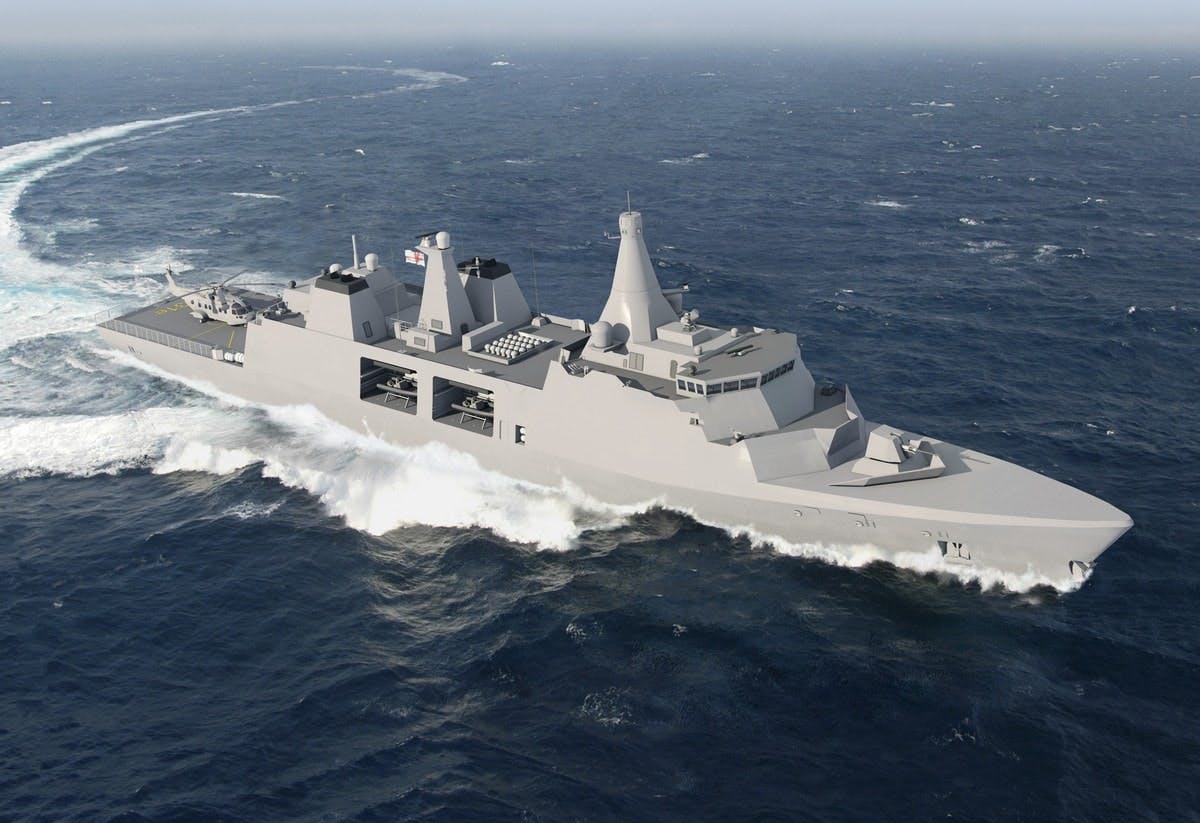
What about other vessels like the new support ships?
The First Minister of Scotland previously stated that the international tendering for auxiliary vessel contracts, specifically the Fleet Solid Support Ship contracts, is a betrayal of the Clyde. This is however despite the yards having no interest in them, having never been promised them and the fact the vessels couldn’t physically fit on the slipway.
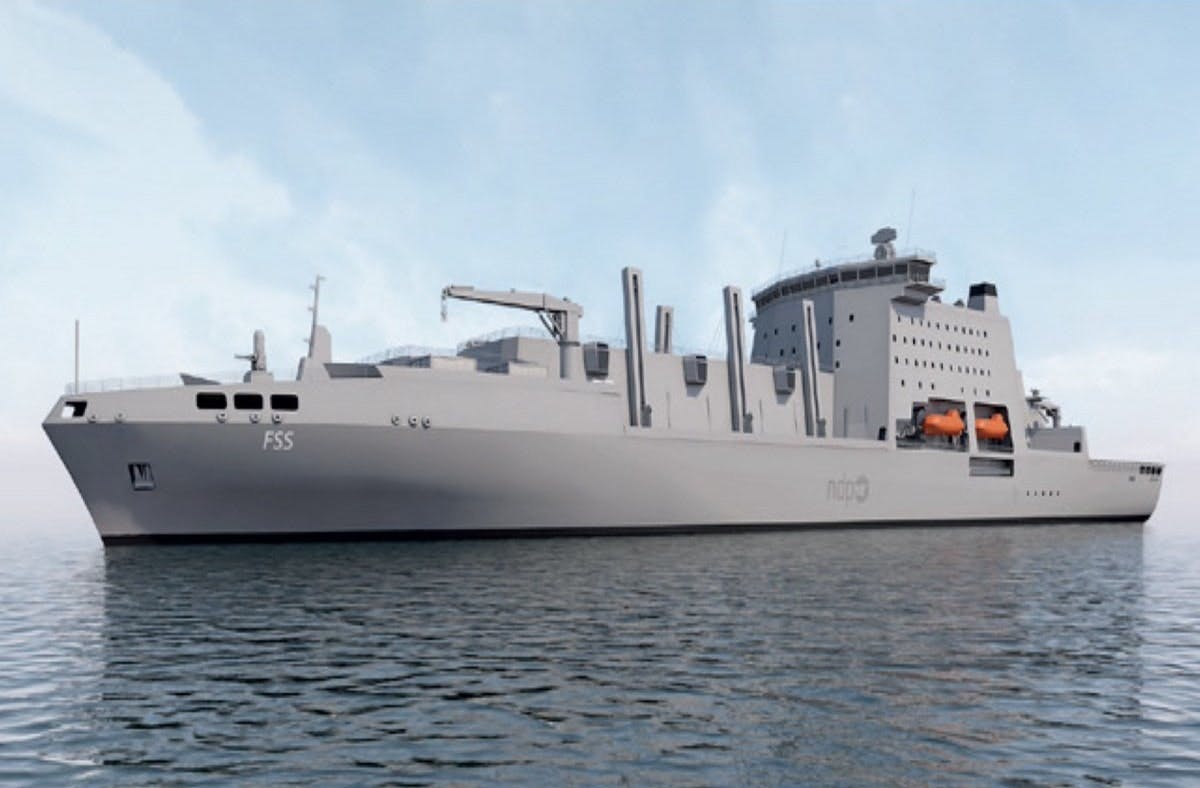
Sturgeon said the move was an “absolute betrayal” in light of promises made in the run-up to 2014’s independence vote. In fact, what was “promised” before the referendum was work on complex warships, like frigates and destroyers.
There are three key problems with this:
- The Clyde is at capacity with the River class and Type 26 Frigate builds and has no intention of bidding for this work.
- The 40,000 tonne support vessels wouldn’t physically fit on the slip alongside the Type 26 Frigate builds.
- The only vessels “promised” were warships, such as frigates and destroyers.
The unions and the UK Defence Journal have been advocating that the build stay in the UK, but the Clyde was never in line to build these ships.
We spoke to a contact at the yard who told us:
“This is the second time this news has popped up and I have no idea why the government in Edinburgh are making these claims, these vessels were not promised to us and they’re not warships.
We’re busy with the last batch of River class ships and the first batch of the City class ships. If I had one message for them, it would be to stop using us a political football, we’re sick of it.”
We also spoke to Stuart Crawford, a retired regular officer in the Royal Tank Regiment and a former SNP defence spokesman. Crawford said:
“Nicola Sturgeon declared that the international tendering process was “a blatant betrayal of Scottish shipyards” and a reneging of promises made to the Clyde shipyards at the time of the Scottish independence referendum in 2014. Other SNP politicians have been quick to jump on the bandwagon, including Humza Yousaf MSP, Minister for Transport and representing a Glasgow constituency. The problem with the ‘Clyde betrayal theme’ is that it is just not based on the evidence. As outlined in the UK Defence Journal, three main facts undermine the argument.
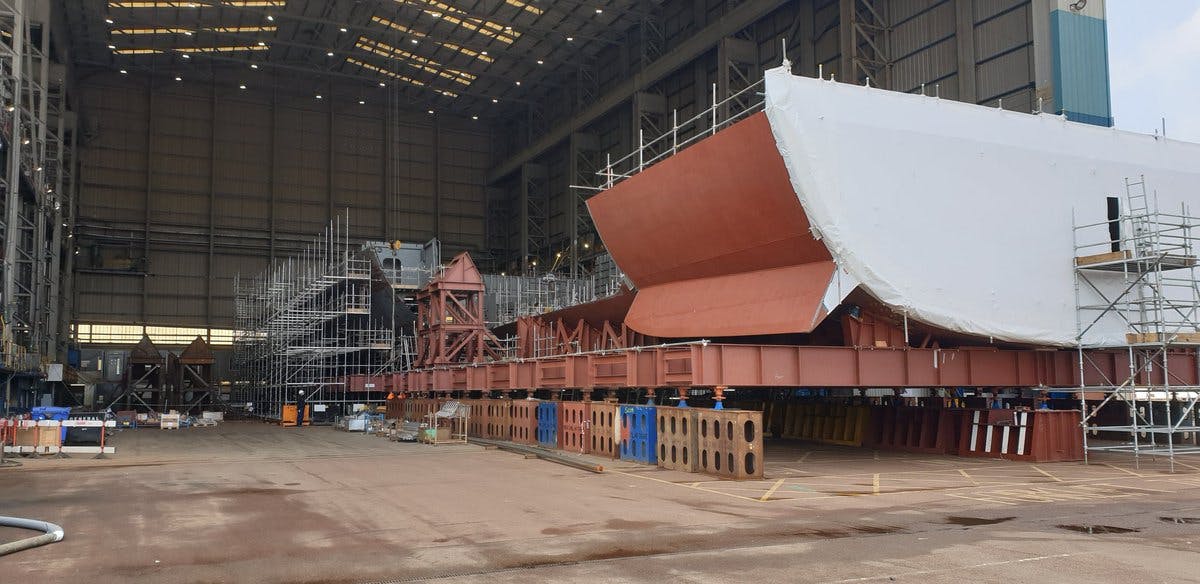
First, the Clyde is already at capacity building the Offshore Patrol Boats and Type 26 frigates that will keep it busy until at least 2030. There is no intention by the Clyde yards to bid for the work in any case. Second, the FSS ships, at a projected size of 40,000 tonnes each, just wouldn’t fit into the existing Clyde facilities. And third, the only ‘promise’ that might possibly have been made relates to complex warships only, of which the Clyde currently has it fill.”
What’s actually happening on the Clyde, is it a ‘betrayal’?
We asked Paul Sweeney, former Member of Parliament for Glasgow North East and a former yard worker at the BAE facilities on the Clyde.
“It is frankly bizarre that Scottish nationalists insist on trying to exploit a line of argument that Clyde shipyard workers have been somehow betrayed when they have job security until the 2030s with the current naval shipbuilding programme. Yes the Type 26 programme was rescoped from thirteen vessels to eight, but that change fails to take into account the additional order of five River Class Batch 2 Offshore Patrol Vessels that were placed on the Clyde to bridge work from the Queen Elizabeth Aircraft Carrier build – the largest naval ships ever built on the Clyde – and the commencement of the Type 26 Frigates, the second of which – Cardiff – will cut steel at Govan this week.

It also doesn’t take into account the significant overseas success of Type 26, with both Australia and Canada selecting the Type 26 for their own domestic frigate programmes against Spanish, Italian and Dutch rivals. This means the Glasgow-based Type 26 is now a global design, with significant involvement of the over one thousand engineering staff in Glasgow on those projects, as well as common purchasing from UK-based suppliers, even though the ships will be constructed in Adelaide and Halifax respectively, as is the norm for any advanced industrial country building ships for its navy.
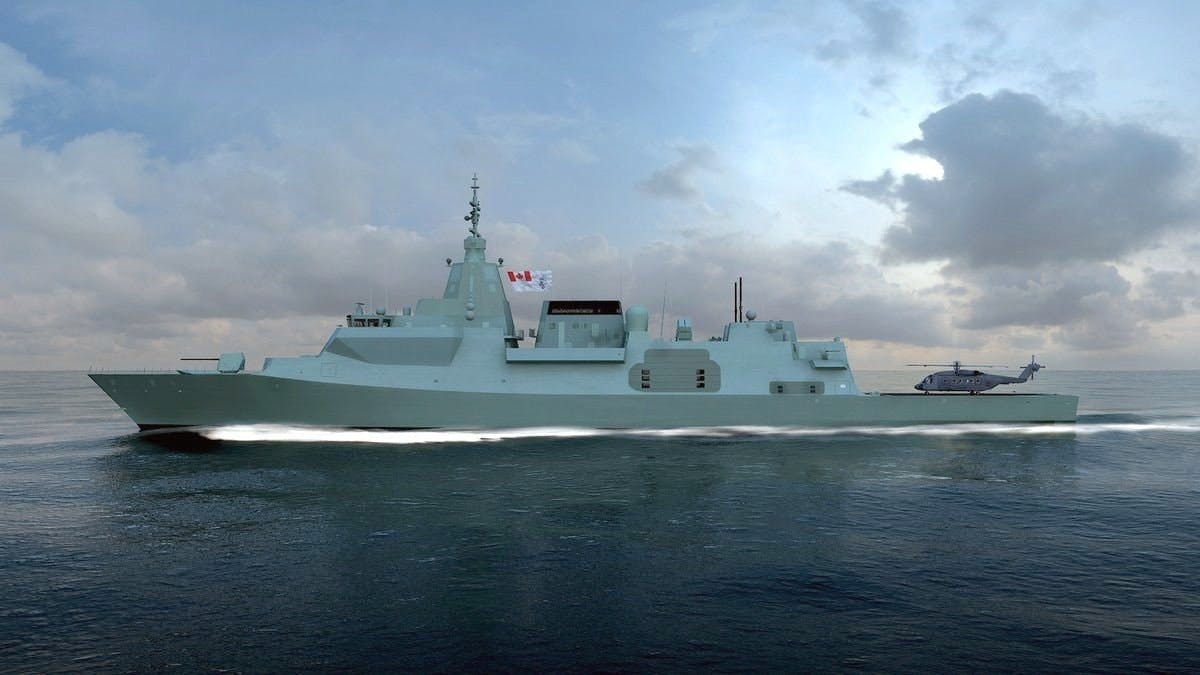
It also doesn’t take into account that the pace of the Type 26 programme has been slowed from a 12 month drumbeat to an 18 month drumbeat, this extending the overall duration of the shipbuilding programme well into the 2030s. It also doesn’t factor in the opportunity of the five planned Type 31e lighter frigates, which will involve Glasgow-based BAE engineers and also construction and assembly at either Ferguson Marine or Rosyth in Fife, with BAE workers likely seconded to support those builds as happened with the aircraft carrier assembly.”
What has been built on the Clyde since 2014 and what are the yards planning on building in future?
So, what does the prospective order-book BAE are talking about actually look like for the next few decades? We’ve included the contracted and non-contracted work the Clyde is expected to build to give an idea of the scale of work already present as BAE cite this as a reason for not bidding for the Type 31e to be assembled on the Clyde.
Ordering in batches is common for projects of this size around the world and was last seen with the Royal Navy for the Type 45 Destroyers and recent Offshore Patrol Vessels. The Type 45s first batch order was for three vessels. Ordering this way allows for changes to specifications and allows for refinements to contracts as working practices evolve and efficiencies are learned.
Let’s get to the point, what has been built in Scotland as a whole since 2014 and what are the yards planning on building in future?
18 ships of three type, excluding the two aircraft carriers, have been or will be launched from Scottish yards between 2014 and the 2030’s.
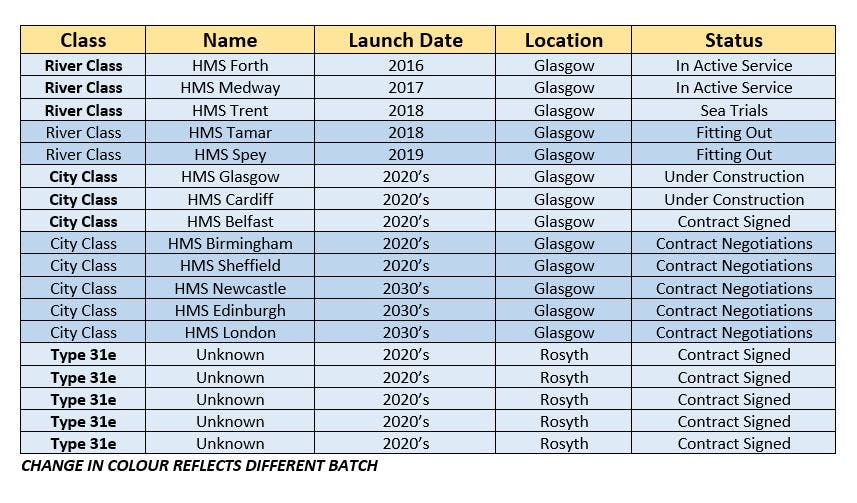
Ordering in batches is common for projects of this size around the world and was last seen with the Royal Navy for the Type 45 Destroyers and recent Offshore Patrol Vessels. The Type 45s first batch order was for three vessels. Ordering this way allows for changes to specifications and allows for refinements to contracts as working practices evolve and efficiencies are learned.
Eight Type 26 Frigates are to be built in total by their designers BAE, the contract for the second batch will be negotiated very soon.
Why have we included it despite this?
There are no other yards in the UK to build the Type 26, it’s a BAE product and their only surface shipyards are in Glasgow. The ships are not going anywhere unless the Royal Navy take the incredibly unlikely decision not to replace their frigate fleet.
The UK Government committed to eight advanced anti-submarine warfare ships in its 2015 Strategic Defence and Security Review (SDSR). The Type 26 programme currently employs more than 1,200 people in the UK supply chain, with a number of contracts already in place for the manufacture of major equipment for the first three ships. In total, there are already 33 UK and international companies working in the supply chain to deliver the Type 26 ships.














Can’t argue with that, except some fear it may be just 3 more T26 ordered and built.
My gut feeling is that BAE have lost interest in frigates, fingers in pies all around the world, and perhaps less in build where there are risks of penalties or even losing money, into other arenas, or should I say, more into others. In some ways I can’t blame them, but in others they’ve had years since the start of the 15 year 2009 TOBA to invest in their own future with shipbiilding, and seem to me to have been lethargic and reluctant to do so.
there is an arrogance from the clyde that they EXPECT every ship built for the R.N. will be theirs to build, this is akin to the monopoly BAE seems to have on equipment procurement, yards like yarrow, harland wolff, devonport and portsmouth should be given the opportunity to show what they can achieve.
“yards like yarrow, harland wolff, devonport and portsmouth”
do not exist anymore.
Eh?
Andy, The Yarrows shipyard at Scotstoun in Glasgow is now part of the BAE complex on the Clyde.
Who are these people on the Clyde showing this “arrogance” you detect? There is no evidence of that attitude in the article. On the contrary:
“We spoke to a contact at the yard who told us:
“This is the second time this news has popped up and I have no idea why the government in Edinburgh are making these claims, these vessels were not promised to us and they’re not warships.
We’re busy with the last batch of River class ships and the first batch of the City class ships. If I had one message for them, it would be to stop using us a political football, we’re sick of it.”
And well said, too!
more t45’s, the R.N needs destroyers.
Makes more sense having an anti air defence type 26 Hull not type 45.
More T45s would be welcome but now unlikely to be built, or at least not until the T26 order is completed in the mid-2030s. Even an AAW frigate derived from the T26 would have to wait until the ASW hulls are completed, as the article above makes clear, the Clyde is fully booked for the foreseeable future.
However, if Arrowhead is indeed chosen for T31, then we could order more of these, equipped with a decent amount of Mk41 or Sylver cells and with the Artisan radar repurpose them as AAW ships.
We could then use them in conjunction with the existing T45s, as the USN uses Ticonderogas and Arleigh Burkes together. Essentially, T45 would fill the CG role and the T31s the DDG role.
With modern datalinks T45 could cue targets using SAMPSON for the T31s to engage.
The T31 would not be a replacement for the missing T45s – you would not have one escorting the carriers in place of a T45, for example – but they would be a cost effective way of supporting T45s in air defence.
I think a variant of the Arrowhead(T31) frigate
would make a good AAW support vessel, but Not a full DDG. It would require an alternative lighter AAW radar, in order to take a more limited top weight of not more then about 5.5Kt.
The variant would supplement the T45 by employing a system called, Cooperative Engagement Capability(CEC), by effectively networking to the T45’s Simpson radar.
Great work UKDJ In still correcting these myths which just won’t go away. what I conclude is these myths are purposely promoted by nationalist politicians, cheerleaders and assorted bloggers to forment grudge & grievance (as see by the recent fury over the RFA support ships) as they have been told so many many times by many ends of the spectrum that these type 26 ships will be built on the Clyde with work stretching to 2030 and beyond and all Naval war ship building has been north of the border in recent decades all to the detriment of ship building in communities in the Northeast, Merseyside, Northern Ireland and the south all to appease Scottish voters so there’s nothing to gripe about at all from nationalists. They really actually don’t care one jot about naval shipbuilding it’s all just grievance material and hatred of anything UK, as witnessed by the shameful silence and ignoring of HMS QElizabeths launch and will assume the same when second Carrier is launched.
what puzzles me most is if they had there way and separated Scotland from the rest of the UK there would be zero, zilch naval shipbuilding so why they get there knickers in a twist about type designation or order numbers is just silly. BAe would close the yards, there maybe a patrol vessel or two built for a Scottish navy but there’s nothing in the nationalist threadbare defence plans which could sustain naval shipbuilding and all them skills would head south sharpish after an independence vote so preserving the union is key to keeping naval shipbuilding in Scotland.
Hi Dave,
When the Queen Elizabeth was floated-out the Rosyth basin in 2017, the roads to the Forth were mobbed by Scots keen to see the carrier afloat for the first time – I was one of those onlookers! And having met a few BAE workers from the Clyde yards, I know they are proud to build warships for the Royal Navy.
I agree – the SNP government has been very quiet about the success of the QE class, and implications for the Clyde yards in the event of independence.
It’s true there is no capacity on the Clyde..but that is because the MoD withdrew support for developing Scotstoun and now more than half the yard is a flattened wasteland.
The number of ships per type doesn’t replace the already merge Royal Navy numbers. The T31e is a false economy. It brings about the question of “when’s a airship not a warship”? When it’s a Royal Navy T31e.
Don’t get me wrong, I am not against any company or yard, it’s just a total waste of money building ships that will not be up to the mark and unless you have a Crystal ball and know world events for the next 40 years! The T31e’s need to be upgraded to fighting standard, even if it means scrapping them and building more T26’s. The Royal Navy will not have the ability to field its Carrier battle groups with the inventory that’s planned, nor will it have the inventory for independent tasks as it currently does.
The Government has forgotten lessons the nation suffered in the last two World Wars, an Island is easy to cut off.
i’ve this feeling the t31 project is a media sap and that the programme won’t happen
[…] For more on what’s going to be built, have a look here. […]
Because of the hatred that the SNP have of Westminster , the MOD could possible say ” It’s time to say Goodbye ” ….could you blame them ? ?
Strange article with some inaccuracies and, by the way, Bae is the prime on Leander.
Now I see comments that are dated a year ago. WTF?
I personally don’t get the bashing that BAE get. They produce world class designs. T45 the worlds best air defence destroyer, only limited by government short sightedness, built to a high standard and whilst costing a billion would have been cheaper if built in larger numbers and still well short of the cost of an Arleigh Burke. T26 a world class design now gaining international orders and expected to be the best sub hunter bar none. Again costs high due to minimal order and several delays out of their control. Astutes – issues in build heavily linked to the government decision to gap between sub types. Regarded as one of the best in the world. A world leader in naval gun design, the only company in the country with knowledge and experience in fifth gen fighter stealth technology and lead company in Tempest etc etc.
To my eyes, every time we ask them to produce something for us they come up with a product that is up there with the best if not THE best. The issues around cost, timescale and weapons fit etc are government created and mostly should not be laid at Bae’s door.
Agree. If I hear a French or German or US product sold as the best I assume its 50% worse than the sales pitch. For a UK product I assume its 50% better. This national false modesty is crippling us. BAE does world class engineering. I believe most of the problems with big defence projects are to do with political indecision and changing user requirements. One look at Brexit is enough to convince any impartial observer that we are a nation of head bangers; our politicians couldn’t agree on the time of day.
The BAE bashing is understandable for 2 reasons.
1) They have little real competition in this country so there is little choice but BAE if we want to retain domestic skills and industry. So prices can raise and all we can do is grumble and pay up.
2) And this is the real reason, HMG dither and change their minds so much and keep making changes that costs go up massively. But they just blame it on BAE because its convenient.
1: the number of units of various platform types ordered during the last few decades only allows one maybe two at most competitors to survive. I don’t think we should blame Bae for being better than the rest and finding themselves the only one left. As long as bae keep producing the goods I’m personally happy. In regards to excessive costs, I just don’t see it and many of our high end products are on par if not cheaper than other countries pay for. Just look at what Australia and Canada are paying for their T26’s!
2: this is the real area that makes me angry. How many times have we heard that we could have had say 12 x for £x but government slow and delay so we only get 6-8 for the same money! If we properly commit to our heavily R&D’d high end platforms, something like a T45 would have come in at £6-800 million if we had ordered the full 12. Now that makes it the same cost as a Fremm, a medium frigate. We could have had our arm bitten off by foreign buyers to get the best AAW destroyer on the planet at that time for that sort of money.
If government had committed to regular upgrades on Typhoon it would have cost initially, but how many more contracts would we have won to offset those costs?
We need to decide what platforms we are going to specialise in and build, and those which we are happy to buy abroad, and then fully commit to our products both in steady production of decent numbers and a progressive consistent upgrade path. Get cost reductions in numbers ordered and gain foreign orders from the hot production line.
1 Like
I agree T.S, they are a World class British company we should be proud of.
Out of curiosity, how possible would it be to build, say, 3 or 4 more Type 45 destroyers? Would it be prohibitably expensive to do now that production has ended? To me seems a good way of increasing potent hull numbers and also boosts the industry, and therefore jobs.
Before reading it should be 8 frigates and 5 OPVs before.
That’s odd. This is a new article but some of the postings go back a year!
Interesting to see that the SNP Defence Spokesman is a retired British Army Officer. I read the other day that lots of SNP members are Engish. What will happen to these order and so on if Scotland votes for independence I wonder?
This is what happens when political decision making is concentrated in one corner of the country and pursues an agenda that is close to the hearts of a few living in selected postcodes of that city and enabled by fractional majorities. Moreover, we need more direct democracy. We’d still be in the EC if people had been given the say on “more Europe” – and I think we’d have been happy with that.
Centralisation has killed the union. In fact the rUK is, in many ways, deeply sympathetic to the anguish of the Scots – because we feel disempowered, marginalised and second class citizens too!
The only way, I see, to take the wind out of the SNP’s sails is full federalisation of the nation and a rowing back of central government’s remit.
We must radically, devolve power to the 12 regions of the UK, and perhaps establish a new senate based AWAY from London, that is responsible for the majority of domestic affairs. Perhaps, such an institution could “tour” the union on a rotating basis?
Defence, foreign relations and the treasury could stay in London and sit at Westminster – though I see no reason why, when we are at peace, these couldn’t also rotate around the UK – we’ve all got Skype now 😉
I agree with all that Nath.
Hi Nath
Don’t be taken in too much by the separatist narrative ……
“In fact the rUK is, in many ways, deeply sympathetic to the anguish of the Scots – because we feel disempowered, marginalised and second class citizens too!..”
Writing as a home-based Scot, we’re hardly disempowered, marginalised or second class citizens ……
Two recent UK Prime Ministers have been Scottish (one representing a constituency in Scotland); currently a Scot (Michael Gove) is essentially Deputy Prime Minister, and we have another Scot just elected to lead the Liberal Party ……. furthermore we have a substantial measure of Home-Rule. Plus Scots have always had their own legal and education system. The Head of State, and her Heir, also have a close association with Scotland – with the Queen visiting the Scottish parliament only a few weeks ago.
Scots also play leading roles in UK industry, the UK civil service – and the media. Scotland has its own BBC channel. And in the defence establishment, a Scot was recently head of the Royal Air Force!
Although Brexit is not to my own liking, some of the most ardent Brexiters can be found in the north-east of Scotland (where Michael Gove comes from).
As Scots, all things considered, we don’t do too badly out the Union …. and having freely voted only five years ago to remain within the UK, that viewpoint is not uncommon.
Some interesting ideas Nath, I’ve no idea why we need to be governed in an old building in London as opposed to a purpose built one for modern society in Birmingham or…. wherever. For starters, after its tarted up we could then charge people money to visit it and ultimately pay for the new one.
I’m not sure some form of federalism would appease the SNP though, they’re ultimately a one policy party and all roads lead to independence. The core of this article being a prime example, RFA’s that were never on the table being an obvious one although Rosyth might be an option, big dry docks there. Don’t get me wrong, they’re not the only party that will play free and easy with things, they all bloody do it unfortunately. Our political class are all snake oil salesmen.
The Clyde has plenty of work.
The issue is 13 Frigates is the new benchmark, the new norm. Whenever cuts happen where is the realistic commitment for an increase? The number should be 20.
There were 16 T23 and 4 T22 B3.
So T31 actually needs to be a class of 12, not 5.
I’ve not heard much commitment from this current government or any other to restore those numbers.
I agree blaming BAE is pointless. Most of the western nation is going on with a single escort shipyard. Why not UK? Also, BAE escorts are expensive just because of high-grade.
But, I think the top priority is NOT “more escort hulls”, but “more ACTIVE escort hulls”. RN lacks man-power, and any new escorts built cannot be manned. Also, the sea-going days is nearly half. This two parts are the top priority to save the royal navy.
In other words, currently RN shall focus on investing in man-power and operation costs. Also, if any assets are to be added, more high-end assets are better than low-end assets, the latter is relatively man-power intensive.
No T13e. Anyway RN cannot man it. Rather, invest on improving the existing assets; T45 with BMD, CEC, or even CAPTAS sonar, T26 added with ExLS for more CAMM, LRASM, better radar, etc.
I agree Donald – plus military aviation is centralised at Warton in Lancashire, and civil-aircraft manufacturing in Wales and the South-West. Plus the car industry is largely situated in the West Midlands. And let’s not forget about the Rolls-Royce complex at Derby.
Is it so unremarkable that the remnants of the ship-building industry is centralised on the Clyde, a location where most UK shipyards have been based during the modern industrial age?
This is solely the SNP bleating-? and the news outlets that support their line, no more/no less.
Still less ships than promised, Britnat! Baaaaaaaaaa.
Irrespective of where the work actually goes we are in a situation where only a short time after the publication of a national shipbuilding strategy Appledore has closed, H&W is in administration and Ferguson in trouble too. We could have lost 3 shipyards by the end of the year. It’s nigh on impossible to diversify away from BAE when British shipyards are incapable of winning orders from the commercial sector to sustain themselves between a shrinking number or RN contracts.